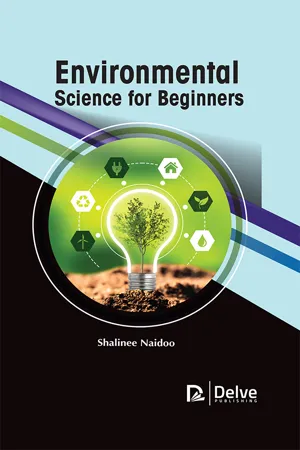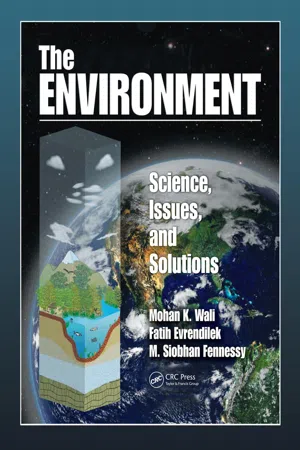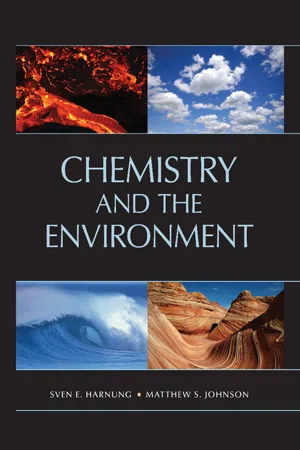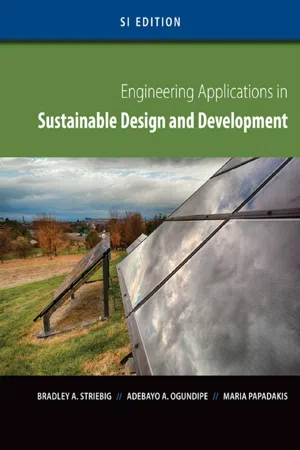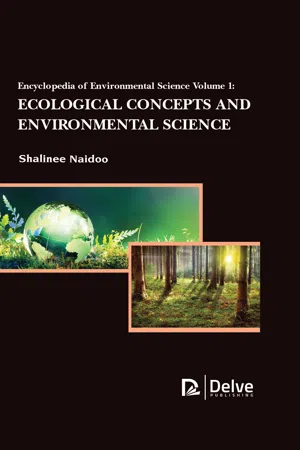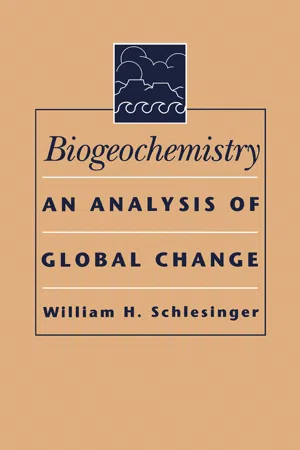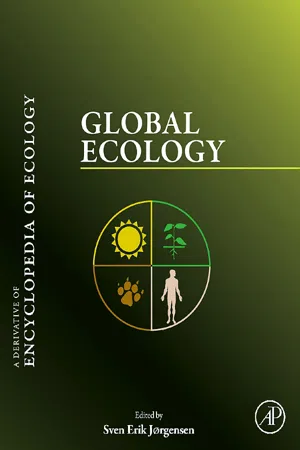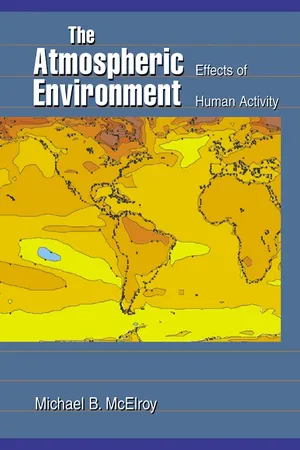Geography
Biogeochemical Cycles
Biogeochemical cycles are pathways through which elements such as carbon, nitrogen, and phosphorus move through the biotic and abiotic components of the Earth. These cycles involve processes like photosynthesis, respiration, decomposition, and weathering, and play a crucial role in maintaining the balance of nutrients and elements in ecosystems. They are essential for sustaining life and regulating the Earth's systems.
Written by Perlego with AI-assistance
Related key terms
1 of 5
12 Key excerpts on "Biogeochemical Cycles"
- eBook - PDF
- Luca Palmeri, Alberto Barausse, Sven Erik Jorgensen(Authors)
- 2013(Publication Date)
- CRC Press(Publisher)
187 12 Biogeochemical Cycles 12.1 Introduction The term biogeochemical cycle refers to the set of pathways involving bio-logical, geological, and chemical processes, by which a chemical element or substance moves through different environmental matrices (as discussed in Chapter 11). Common synonyms of biogeochemical cycle are turnover or cycling of substances (e.g., P or N cycling). Cycling means that, after a specific amount of time, the substance is found back in the starting phase and the set of pathways is then repeated. For example, circulation of chemical elements, such as carbon, oxygen, nitrogen, phosphorus, calcium, and water, through various ecospheres is referred to as biogeochemical cycle. Depending on the particular environmental conditions, various elements show characteristic cycling periods . While cycling throughout the ecospheres, an element may be accumulated in specific places, called reservoirs . For example, in aquatic ecosystems, phosphorus is often accumulated in the bottom sediment. Generally, reservoirs hold substances for times significantly longer than the cycling period. The length of time that a chemical is detained in one place is called its residence time . When chemicals are seized for a short period, they belong to exchange pools (e.g., plants and animals). Cycling time and storage time are critical factors defining the behavior and role of a particular sub-stance or element throughout its biogeochemical cycle. Ecologically relevant Biogeochemical Cycles are water, oxygen, carbon, nitrogen, phosphorus, and sulfur. Climate change and human impacts are drastically changing the speed, intensity, and balance of some relatively unknown cycles (e.g., the mercury cycle as well as the cycle of atrazine). Due to the troubling ecological implications, these cycles are increasingly studied. - eBook - PDF
- Shalinee Naidoo(Author)
- 2023(Publication Date)
- Delve Publishing(Publisher)
Environmental Science for Beginners 84 Figure 9: Overview of the cycling of water. NUTRIENT CYCLING The cycling of nutrients forms some of the most important processes that occur within an ecosystem as these cycles highlight the use, movement and recycling pathways within an environment. While elements such as carbon, oxygen, hydrogen, phosphorus, and nitrogen are essential in forming the basic building blocks of life, it should be remembered that there are also many other elements that are needed for the existence of living organisms. These elements are able to move between the abiotic and biotic spheres of an ecosystem in closed cycles which allow for recycling through various geological, biological and chemical cycles within the living biosphere, non-living lithosphere and hydrosphere. Within these cycles, plants take up carbon dioxide from the air and water while also utilizing minerals from the soil to aid in the production of carbohydrates, fats, and proteins thereby promoting growth and reproduction. From here, these carbohydrates, fats and proteins pass into the food chain and can be utilized by herbivores and carnivores before eventually returning to the abiotic environment when dead plant and animal tissue decomposes. Nutrient cycles are more commonly known as Biogeochemical Cycles – the name of which perfectly illustrates the interconnectedness of these elements within the biological, geological and chemical spheres. The most commonly described and therefore important of the cycles are carbon, nitrogen, phosphorus and sulfur. These Biogeochemical Cycles can be broken down into two main types, namely local and global cycles. Local cycles involve the transfer of elements over Environmental Interactions, Cycles and Systems 85 long distances and global cycles in which elements are exchanged between the atmosphere and ecosystem. - eBook - PDF
The Environment
Science, Issues, and Solutions
- Mohan K. Wali, Fatih Evrendilek, M. Siobhan Fennessy(Authors)
- 2009(Publication Date)
- CRC Press(Publisher)
97 Topics Biogeochemical Cycles Drivers of Biogeochemical Cycles Hydrological or Water Cycle Gaseous Cycles Mineral or Sedimentary Cycles Interactions of Biogeochemical Cycles 6 Biogeochemical Cycling of Materials Biogeochemical Cycles Biogeochemical Cycles and energy flows establish not only the links among ecosystem components (biosphere, atmosphere, lithosphere, and hydrosphere) but also the link among ecosystems at local, regional, and global scales. Unlike energy that flows in one direction only, in nature, materials (including water) are cycled and reused within and among ecosystems over and over again. But together, the energy flow (energetics) and material cycling are the two funda-mental and complementary models of ecosystems (Reiners 1986). Within the biosphere, Biogeochemical Cycles describe how an element moves through the biotic and abiotic portion of an ecosys-tem. In doing so, both the transformation and transport of elements occur. The transport of elements can occur by the movement of wind, water, or animals. In some cases, cycling involves little move-ment—only a conversion from one form of a chemical to another (e.g., the uptake of nitrate by a plant and its conversion to an amino acid) or by a chemical reaction (e.g., the oxidation of methane in a lake to carbon dioxide and water by a bacterium). These relation-ships are often summarized in compartmental models, or “box and arrow” diagrams. These consist of compartments (or pools) repre-senting the mass of a given element in a particular chemical form and location. Compartments are connected to one another with links reflecting the movement of elements as they are transported or transformed between them. Because the cycles of materials involve biological, geological, and chemical components of an ecosystem, they are called biogeo-chemical cycles. In many cases, the cycles of elements are also referred to as nutrient cycles; however, all elements (including toxic elements) cycle in nature. - eBook - PDF
- Sven E. Harnung, Matthew S. Johnson(Authors)
- 2012(Publication Date)
- Cambridge University Press(Publisher)
7 Global cycles of the elements 7.1 Biogeochemical Cycles The Wilson cycles circulate elements are circulating through the crust over long time periods, as discussed in Section 1.4. Cycling of material within and between the atmosphere, hydrosphere, and biosphere is typically much faster. Biogeochemical Cycles are flows of matter within and between the spheres as defined in the preceding Chapters 3 to 6. These flows are driven by solar energy, and they begin and end in the crust, which acts as the main reservoir of nearly all elements. Motions within the crust are driven by energy from radioactive decay, and the circulations of the atmosphere and ocean are driven by the sun. In fact, Biogeochemical Cycles are processes that take place within an open physicochemical system as depicted in Figure 7.1 . The spheres are marked by ellipses, and their mutual interactions are indicated by arrows. We refer to the discussion of open systems in Section 2.2b, in particular with respect to the significance of the surroundings. The system can be treated in its entirety, but usually the focus is on a few chemical elements and their flow within and through the subsystems. Since 1971, the International Council for Science (ICSU) committee SCOPE a has published a series of reports on the global turnover of elements central to the environment. Because of their importance for life, the nonmetals C, N, P, and S have been taken up several times, but Cl, Pb, Hg, Cd, and As have also been investigated. In Sections 7.2 through 7.6 of this chapter, we will follow the approach of SCOPE, that is, little emphasis is given to the details of the biochemical processes involved. Anthropogenic perturbations to the Biogeochemical Cycles are of growing impor-tance. They include the use of fossil fuels, the emission of substances such as carbon dioxide and fertilizers, and the discharge of domestic and industrial wastes. - Bradley Striebig, Adebayo Ogundipe, Maria Papadakis, , Bradley Striebig, Adebayo Ogundipe, Maria Papadakis, , Bradley Striebig, Adebayo Ogundipe, Maria Papadakis(Authors)
- 2015(Publication Date)
- Cengage Learning EMEA(Publisher)
3.2 Biogeochemical Cycles Elements such as carbon, oxygen, hydrogen, nitrogen, and phosphorus are prereq-uisites for life. However, an overabundance of any of these elements in different parts of the ecosystem can cause an imbalance in the system and produce unwanted changes. Biogeochemical Cycles help us understand and interpret how chemicals interact in the environment. Biogeochemical Cycles are defined as “the biological and chemical reservoirs, agents of change and pathways of flow from one reservoir of a chemical on earth to another reservoir” (Mays, 2007, p. 57). These biogeochem-ical cycles help us understand what happens to important elements and compounds that influence our lifestyle. Perturbations, or changes to the water and carbon cycles, have long-range and important consequences for our environment and future generations. Biogeochemical Cycles describe the transport, storage, and conversion of com-pounds. The chemical form and process may determine how much of a compound is found in the atmosphere, oceans, or soil. Scientists and engineers use mathemat-ical models, or descriptions, of these processes to predict how long compounds will reside in a certain reservoir and how they are converted to different reservoirs or different forms. The reservoir or repository is the place where these compounds may be found on Earth. For instance, most of the water on our planet is found in the oceans as shown in Table 3.1. Water is also found in the atmosphere but cycles T A B L E 3 . 1 Major repositories for carbon, nitrogen, and water REPOSITORY MAGNITUDE 3 10 12 kg Carbon (C) Water (H 2 O) Nitrogen (N) Atmosphere 735 13,000 3.9 3 10 6 Geologic (soils, ice, groundwater, etc) 10 7 37,600 150 Ocean seawater 40,000 1.4 3 10 6 350 Dead organic mater 3,540 Negligible 400 Living organisms 562 3 7.8 Based on Harte, 1988. Pp. 238-262. Copyright 2016 Cengage Learning. All Rights Reserved. May not be copied, scanned, or duplicated, in whole or in part.- eBook - PDF
- Amrita Pandey(Author)
- 2019(Publication Date)
- Delve Publishing(Publisher)
The important materials that generally recycle on the surface of the earth are carbon, oxygen, hydrogen, nitrogen, phosphorus and sulfur. These are known to have an important role on the surface of earth as they are extremely important for life. Most of the Biogeochemical Cycles function across the world and they are the important means of interaction between several components of the earth system. Biogeochemical Cycles are the channels through which several compounds and energy are continuously transferred among geosphere, hydrosphere, atmosphere and biosphere. There may be some Biogeochemical Cycles which are extremely important for life as these cycles are important for the vital metabolic processes in several living organisms. There are some biotic and abiotic factors which are organic and inorganic in nature that are part of several Biogeochemical Cycles. Biogeochemical Cycles refer to the flow of energy and compounds among the different components of the earth systems such as hydrosphere, geosphere, biosphere and atmosphere. Water is an important element which is vital for all the cycles and different earth systems. There are three important Biogeochemical Cycles which form the important interrelationship between the different components of the earth systems. The important Biogeochemical Cycles are mentioned below and they are: • nitrogen cycle; • carbon cycle; and • sulfur cycle. Introduction to the Earth System and Its Components 17 1.4.1. Nitrogen Cycle Nitrogen cycle is known to be an important cycle of the Biogeochemical Cycles and these cycles are known to be extremely fast and highly complex cycles. The atmosphere generally consists of a lot of nitrogen in gaseous forms and there would be several microorganisms and some living organisms which are equipped with the mechanism to fix the atmospheric nitrogen. The fixing of atmospheric nitrogen refers to the process of making the gaseous nitrogen to be readily available for absorption. - eBook - PDF
Encyclopedia of Environmental Science Vol1
Ecological Concepts and Environmental Science
- Shalinee Naidoo(Author)
- 2019(Publication Date)
- Delve Publishing(Publisher)
Ecological Concepts and Environmental Science 122 20.0. Biogeochemical Cycles Energy flows in certain directions through the ecosystems of the Earth. It enters in the form of radiation energy from the Sun and exits in the form of heat while the chemical components are recycled. This inevitably means that the atoms cycling through the various spheres have been there for a very long time and have just been moving from one sphere to the next (Figure 35). Figure 35: Flow of usable and lost energy within the biosphere. Chemical nu-trients are continuously recycled between producers, consumers, decomposers and inorganic nutrient pool. Usable energy flows between the sun, producers, consumers and decomposers. Energy is also lost in the form of heat [Adapted from Eva Horne and Robert A Bear]. There are four distinct regions on the surface of the Earth and these are divided into the lithosphere (rocks forming the solid surface), hydrosphere (oceans, lakes, rivers, and icecaps), biosphere (community of living organisms) and atmosphere (air around us). Nutrients and materials move cyclically among these spheres. Many of these materials originate within the lithosphere in rocks. They are often released by weathering and subsequently enter water in the hydrosphere. From here, these nutrients are taken up by plants and enter animals and other organisms in the biosphere. They may then enter the atmosphere or re-enter water in hydrosphere. From here they can then enter the hydrosphere via oceans and be taken up by marine organisms. If these marine organisms from the biosphere are washed to the ground via rain, they are then returned to land. Ecological Concepts and Environmental Science 123 20.1. WHAT DRIVES BIOGEOCHEMICAL SYSTEMS? There are six commonly found elements that are present in a variety of chemical forms. - eBook - PDF
- Jose Galizia Tundisi, Takako Matsumura Tundisi(Authors)
- 2012(Publication Date)
- CRC Press(Publisher)
Biogeochemical Cycles 10 SUMMARY The cycles of chemical elements and substances are interrelated with biological, geochemi-cal and physical processes. The distribution and concentration of elements and substances in water depend on ‘fixation’ and the active concentration of macronutrients (carbon, hydro-gen, nitrogen, phosphorus and sulphur) and micronutrients (magnesium, iron, copper and zinc). Macronutrients and micronutrients alike are found in living organic matter, particulate matter, decomposing matter, or dissolved in water. The nutrient recycling rate depends on the interactions between vertical and horizontal mixing and the activity and biomass of aquatic organisms. The vertical distribution of nutrients is affected by the vertical circulation in lakes or reser-voirs and depends on the type of circulation and its frequency. Bacteria with varying physiologi-cal and biochemical characteristics play a key role in Biogeochemical Cycles. Bottom sediment in rivers, lakes, reservoirs, estuaries and interstitial waters provide important quantitative and qualitative nutrient reserves. The availability of nutrients in sediment and interstitial waters depends on oxido-reductive processes and the anoxic or oxic layers of the sediment. Biogeochemical Cycles are involved in the interactions of terrestrial and aquatic organisms. Aquatic macrophytes in the Corrego do Geraldo, UHE Carlos Botelho reservoir (Lobo/Broa). Photo : J. G. Tundisi. 348 Limnology 10.1 THE DYNAMICS OF Biogeochemical Cycles As shown in Chapter 5, the composition of natural waters largely depends on the geochemistry of the water basin and the main characteristics and processes in the basin: soil types , uses and agricultural practices. In inland waters, the distribution of nutrients is also influenced by regenerative processes in the lake’s deepest layers and the sediment-water interface. - eBook - PDF
Biogeochemistry
An Analysis of Global Change
- William H Schlesinger(Author)
- 2012(Publication Date)
- Academic Press(Publisher)
Ephraums. (eds.). 1990 Climate Change: The IPCC Scientific Assessment. Cambridge University Press, Cambridge. Trabalka, J.R. (ed.). 1985. Atmospheric Carbon Dioxide and the Global Carbon Cycle. U.S. Department of Energy, Washington, D.C. Woodwell, G.M. (ed.). 1984. The Role of Terrestrial Vegetation in the Global Carbon Cycle: Measurement by Remote Sensing. Wiley, New York. 12 The Global Cycles of Nitrogen and Phosphorus Introduction The Global Nitrogen Cycle Land Sea Temporal Variations in the Global Nitrogen Cycle Nitrous Oxide: An Unbalanced Global Budget The Global Phosphorus Cycle Linking the Global Cycles of C, N, and Ρ Summary Recommended Reading Introduction T h e availability of nitrogen and phosphorus controls many aspects of global biogeochemistry. Nitrogen often limits the rate of net primary production on land and in the sea. Nitrogen is an integral part of the enzymes that control the biochemical reactions in which carbon is re-duced or oxidized. Phosphorus is an essential component of DNA, ATP, and the phospholipid molecules of cell membranes. Changes in the avail-ability of Ν and Ρ through geologic time have controlled the size and activity of the biosphere. A large number of biochemical transformations of nitrogen are possi-ble, since nitrogen is found at valence states ranging from -3 (in N H 3 ) to + 5 (in N 0 3 ~ ) . Various microbes capitalize on the potential for transfor-mations between these states, and use the energy released by the changes in redox potential to maintain their life processes (Rosswall 1982). Col-lectively these microbial reactions drive the global cycle of nitrogen (Fig. 12.1). T h e most abundant form of nitrogen at the surface of the Earth, N 2 , is the least reactive species. Various processes convert atmospheric N 2 322 12. The Global Cycles of Nitrogen and Phosphorus Atmosphere 323 Anaerobic conditions Figure 12.1 Microbial transformations of nitrogen in the global cycle. - eBook - PDF
Biogeochemistry
An Analysis of Global Change
- William H. Schlesinger(Author)
- 2012(Publication Date)
- Academic Press(Publisher)
Col-lectively these microbial reactions drive the global cycle of nitrogen (Fig. 12.1). T h e most abundant form of nitrogen at the surface of the Earth, N2, is the least reactive species. Various processes convert atmospheric N 2 322 12. The Global Cycles of Nitrogen and Phosphorus 323 Atmosphere Photosynthesis Bacterial degradation Nitrification Aerobic conditions Bacterial degradation Anaerobic conditions Figure 12.1 Microbial transformations of nitrogen in the global cycle. From Wollast (1981). to one of the forms ot fixed nitrogen that can be used by biota. Other bacteria return nitrogen to the atmosphere as N 2 . In contrast, whether it occurs in nature or in biochemistry, phosphorus is almost always found in combinations with oxygen (i.e., as Ρθ4 3 ~), and the availability of phosphorus is largely controlled by rock weathering and the geochemical reaction of Ρ with soil minerals. These lower the solubility of phosphorus in water, leaving only small quanitites for biota. O n land and in the sea, there are few responses of biota to increase the rate of weathering or the availability of P. Transformations of organic phosphorus in soils and ocean waters constitute a biogeochemical cycle that exists on top of the unrelenting flow of phosphorus from weathered rock to ocean sediments. T h e global Ρ cycle is complete only when sedi-mentary rocks are lifted above sea level and weathering begins again. 324 Global Cycles In this chapter we will examine our current understanding of the global cycles of Ν and P. We will attempt to balance an Ν and Ρ budget for the world's land area and the sea. For N, the rate of fixation through geologic time determines the nitrogen available to biota and the global biogeo-chemical cycle. We will review ideas about the rate of nitrogen fixation and denitrification in the geologic past. - eBook - PDF
- Sven Erik Jørgensen(Author)
- 2010(Publication Date)
- Academic Press(Publisher)
8: Biogeochemistry . Oxford: Elsevier – Pergamon. Jacobson MZ (2002) Atmospheric Pollution: History, Science, and Regulation . New York: Cambridge University Press. Keeling RF (1995) The atmospheric oxygen cycle: The oxygen isotopes of atmospheric CO and O and the O/N ratio (U.S. National Report to IUGG, 1991–1994). Reviews of Geophysics 33(supplement): 95RG00438. Margulis L and Schwartz KV (1988) Five Kingdoms , 2nd edn. New York: W. H. Freeman. Schlesinger WH (1997) Biogeochemistry: An Analysis of Global Change . San Diego: Academic Press. Turco RP (2002) Earth Under Siege: From Air Pollution to Global Change , 2nd edn. New York: Oxford University Press. Turekian KK (1996) Global Environmental Change: Past, Present, and Future . Upper Saddle River, NJ: Prentice Hall. Volk T (1998) Gaia’s Body: Toward a Physiology of Earth . New York: Copernicus and Springer. Phosphorus Cycle Y Liu and J Chen , Tsinghua University, Beijing, People’s Republic of China ª 2008 Elsevier B.V. All rights reserved. Introduction The Human-Intensified Phosphorus Cycles Ecological Impacts of Phosphorus Use Regulating the Societal Phosphorus Flows Further Reading Introduction Phosphorus (P) is important because it is an essential ingredient of the energy metabolism of all forms of life. It is one of the three macronutrients needed by all crops (together with N and K). Human activity has quadrupled the mobilization of phosphorus and although the avail-ability of this nonrenewable resource does not seem to pose a problem at the moment, there are other aspects of our phosphorus metabolism which do require our attention, namely the wastes (water and soil sinks) and how we affect the normal cycle of phosphorus on Earth. Throughout the metabolism of phosphorus in our econ-omy, there are large amounts of wastes and emissions as will be shown later. - eBook - PDF
The Atmospheric Environment
Effects of Human Activity
- Michael B. Mcelroy(Author)
- 2021(Publication Date)
- Princeton University Press(Publisher)
Cycles of Nitrogen, Phosphorus, and Sulfur Living organisms require a variety of chemical elements for healthy growth. Carbon, hydrogen, oxygen, nitrogen, phosphorus, and sulfur constitute what may be called the macronutrients, the major elements of living organisms. The minor elements—the micronutrients—include sodium, magnesium, potassium, calcium, iron, manganese, fluorine, chlorine, and bromine. Our discussion of the carbon cycle in the preceding chapter outlined the impor- tance of carbon, hydrogen, and oxygen. Supplied in the form of CO 2 and H 2 O, these elements furnish the essential ingredients for photosynthesis. This chapter introduces the Biogeochemical Cycles regulating the supply of the other macronutrients: N, P, and S. We begin in Section 12.1 with a discussion of the nitrogen cycle. A major fraction of Earth’s nitrogen resides in the atmosphere as N 2 . In this form, how- ever, the element is relatively inaccessible to biological organisms. Before it can be incorporated in biological tissue, it must be fixed; meaning it must be trans- formed from the relatively inert form of N 2 to more accessible compounds such as NH 4 + and NO 3 – . A specific motivation in this Section is to understand the factors responsible for the rise in the abundance of N 2 O over the past sev- eral centuries. As previously noted, N 2 O is an important greenhouse gas. It also plays a critical role in the chemistry of the stratosphere. An increase in the abundance of N 2 O may be expected to result in an increase in the global aver- age temperature at Earth’s surface, accompanied by a drop in the abundance of O 3 in the stratosphere. The concentration of N 2 O is presently increasing at a rate roughly comparable to that of CO 2 : while the increase in CO 2 may be at- tributed mainly to combustion of fossil fuels, more subtle influences, it ap- pears, are responsible for the rise in N 2 O.
Index pages curate the most relevant extracts from our library of academic textbooks. They’ve been created using an in-house natural language model (NLM), each adding context and meaning to key research topics.

